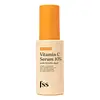What's inside
What's inside
 Key Ingredients
Key Ingredients

 Benefits
Benefits

 Concerns
Concerns

No concerns
 Ingredients Side-by-side
Ingredients Side-by-side

Water
Skin ConditioningButylene Glycol
HumectantPropylene Glycol
HumectantNiacinamide
SmoothingGlycerin
HumectantSodium PCA
HumectantAlpha-Arbutin
AntioxidantCentella Asiatica Extract
CleansingCamellia Sinensis Leaf Extract
AntimicrobialLactobacillus/Collagen/Mesembryanthemum Crystallinum Leaf Extract Ferment Lysate
Skin ConditioningArisaema Amurense Extract
Skin ConditioningAllantoin
Skin ConditioningHydrolyzed Collagen
EmollientDecyl Glucoside
CleansingTranexamoyl Dipeptide-23
BleachingPolyglutamic Acid
Skin ConditioningArbutin
AntioxidantSodium Hyaluronate
HumectantAcetyl Tyrosine
Skin ConditioningSaxifraga Sarmentosa Extract
Skin ConditioningPaeonia Suffruticosa Root Extract
Skin ProtectingAminopropyl Ascorbyl Phosphate
AntioxidantHydrolyzed Hyaluronic Acid
HumectantHydroxypropyltrimonium Hyaluronate
Scutellaria Baicalensis Root Extract
AstringentGlutathione
Sodium Acetylated Hyaluronate
HumectantPhenoxyethanol
PreservativeHydroxyethylcellulose
Emulsion StabilisingDisodium EDTA
1,2-Hexanediol
Skin ConditioningCitric Acid
BufferingSodium Sulfite
PreservativeCaprylyl Glycol
EmollientEthylhexylglycerin
Skin ConditioningWater, Butylene Glycol, Propylene Glycol, Niacinamide, Glycerin, Sodium PCA, Alpha-Arbutin, Centella Asiatica Extract, Camellia Sinensis Leaf Extract, Lactobacillus/Collagen/Mesembryanthemum Crystallinum Leaf Extract Ferment Lysate, Arisaema Amurense Extract, Allantoin, Hydrolyzed Collagen, Decyl Glucoside, Tranexamoyl Dipeptide-23, Polyglutamic Acid, Arbutin, Sodium Hyaluronate, Acetyl Tyrosine, Saxifraga Sarmentosa Extract, Paeonia Suffruticosa Root Extract, Aminopropyl Ascorbyl Phosphate, Hydrolyzed Hyaluronic Acid, Hydroxypropyltrimonium Hyaluronate, Scutellaria Baicalensis Root Extract, Glutathione, Sodium Acetylated Hyaluronate, Phenoxyethanol, Hydroxyethylcellulose, Disodium EDTA, 1,2-Hexanediol, Citric Acid, Sodium Sulfite, Caprylyl Glycol, Ethylhexylglycerin
Water
Skin Conditioning3-O-Ethyl Ascorbic Acid
Skin ConditioningEthoxydiglycol
HumectantButylene Glycol
HumectantPanthenol
Skin ConditioningTriethanolamine
BufferingFerulic Acid
AntimicrobialAllantoin
Skin ConditioningPhenoxyethanol
PreservativePentylene Glycol
Skin ConditioningSodium Hyaluronate
HumectantGlycerin
HumectantTocopheryl Acetate
AntioxidantLactobacillus/Lemon Peel Ferment Extract
Skin ConditioningCitrus Aurantium Dulcis Peel Extract
Emulsion StabilisingAcrylates/C10-30 Alkyl Acrylate Crosspolymer
Emulsion StabilisingTranexamic Acid
AstringentTranexamoyl Dipeptide-22
BleachingNicotinoyl Dipeptide-22
Skin ConditioningBifida Ferment Lysate
Skin ConditioningEthylhexylglycerin
Skin ConditioningSodium Bisulfite
AntioxidantWater, 3-O-Ethyl Ascorbic Acid, Ethoxydiglycol, Butylene Glycol, Panthenol, Triethanolamine, Ferulic Acid, Allantoin, Phenoxyethanol, Pentylene Glycol, Sodium Hyaluronate, Glycerin, Tocopheryl Acetate, Lactobacillus/Lemon Peel Ferment Extract, Citrus Aurantium Dulcis Peel Extract, Acrylates/C10-30 Alkyl Acrylate Crosspolymer, Tranexamic Acid, Tranexamoyl Dipeptide-22, Nicotinoyl Dipeptide-22, Bifida Ferment Lysate, Ethylhexylglycerin, Sodium Bisulfite
 Reviews
Reviews

Ingredients Explained
These ingredients are found in both products.
Ingredients higher up in an ingredient list are typically present in a larger amount.
Allantoin is a soothing ingredient known for its protective and moisturizingg properties. Because of this, it is often added to products with strong active ingredients.
Studies show higher concentrations of this ingredient can promote wound healing.
Though it can be derived from the comfrey plant, allantoin is produced synthetically for cosmetic products to ensure purity.
Learn more about AllantoinButylene Glycol (or BG) is used within cosmetic products for a few different reasons:
Overall, Butylene Glycol is a safe and well-rounded ingredient that works well with other ingredients.
Though this ingredient works well with most skin types, some people with sensitive skin may experience a reaction such as allergic rashes, closed comedones, or itchiness.
Learn more about Butylene GlycolEthylhexylglycerin (we can't pronounce this either) is commonly used as a preservative and skin softener. It is derived from glyceryl.
You might see Ethylhexylglycerin often paired with other preservatives such as phenoxyethanol. Ethylhexylglycerin has been found to increase the effectiveness of these other preservatives.
Glycerin is already naturally found in your skin. It helps moisturize and protect your skin.
A study from 2016 found glycerin to be more effective as a humectant than AHAs and hyaluronic acid.
As a humectant, it helps the skin stay hydrated by pulling moisture to your skin. The low molecular weight of glycerin allows it to pull moisture into the deeper layers of your skin.
Hydrated skin improves your skin barrier; Your skin barrier helps protect against irritants and bacteria.
Glycerin has also been found to have antimicrobial and antiviral properties. Due to these properties, glycerin is often used in wound and burn treatments.
In cosmetics, glycerin is usually derived from plants such as soybean or palm. However, it can also be sourced from animals, such as tallow or animal fat.
This ingredient is organic, colorless, odorless, and non-toxic.
Glycerin is the name for this ingredient in American English. British English uses Glycerol/Glycerine.
Learn more about GlycerinPhenoxyethanol is a preservative that has germicide, antimicrobial, and aromatic properties. Studies show that phenoxyethanol can prevent microbial growth. By itself, it has a scent that is similar to that of a rose.
It's often used in formulations along with Caprylyl Glycol to preserve the shelf life of products.
Sodium Hyaluronate is hyaluronic acid's salt form. It is commonly derived from the sodium salt of hyaluronic acid.
Like hyaluronic acid, it is great at holding water and acts as a humectant. This makes it a great skin hydrating ingredient.
Sodium Hyaluronate is naturally occurring in our bodies and is mostly found in eye fluid and joints.
These are some other common types of Hyaluronic Acid:
Learn more about Sodium HyaluronateWater. It's the most common cosmetic ingredient of all. You'll usually see it at the top of ingredient lists, meaning that it makes up the largest part of the product.
So why is it so popular? Water most often acts as a solvent - this means that it helps dissolve other ingredients into the formulation.
You'll also recognize water as that liquid we all need to stay alive. If you see this, drink a glass of water. Stay hydrated!
Learn more about Water